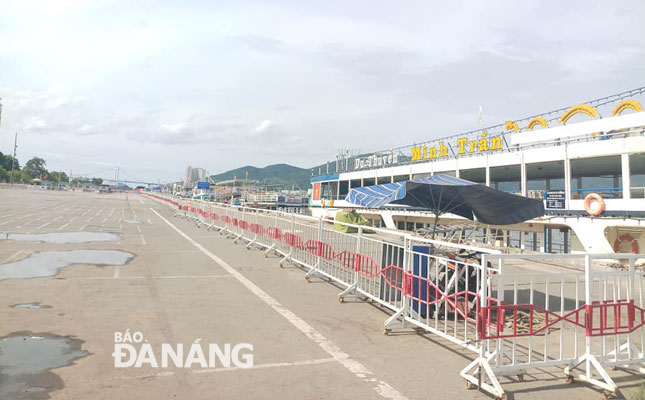City in urgent need of new tourism products
Given privileges that nature has generously bestowed on Da Nang, it is an urgent need for this locality to develop new special, high-end tourism products. This demonstrates the city’s attempt to lure more visitors from both home and abroad, inspire them to extend their stay periods and increase their spending here, return later, and recommend this attractive destination to others.
 |
| Many tourism business now want the Da Nang Port area, at the end of Nhu Nguyet Street, into a tourist wharf in order to diversify local waterway tourism products (Photo: Khanh Hoa) |
A DA NANG Newspaper reporter recently collected constructive opinions from representatives of some local prestigious tourism businesses about how to make Da Nang even more inviting in the eyes of tourists.
Mr Le Minh Phuc, the General Director of VinaCapital Da Nang cum Deputy Head of the Da Nang FDI Businesses’ Club, underlined a must-do for the city to open new high-quality night markets and pedestrian spaces as soon as possible. In his further explanations, Mr Phuc noted that visitors always want to access hangouts to eat, shop and explore during their stay in this vibrant, beautiful city.
It is also essential that the city should promote the appeals for more investment from both home and aboard into the development of pedestrian zones, night markets, spaces for community tourism activities, and night amusement and entertainment areas, and these are ideal ways to encourage to visitors to increase their spending.
Offering another perspective, Mr Dang Hoa, the Head of the city’s Waterway Tourism Association, said it is high time for the city to develop even more attractive waterway tourism products in the coming time. In fact, the tourism development potential of the iconic Han River has yet to be fully tapped over the past years.
The city’s Waterway Tourism Association, over recent years, has given some ideal suggestions and recommendations about boosting the development of such beach holiday tourism products as yachts, cruise ships, squid fishing at night, diving to explore the coral reefs, as well as developing various types of beach sports serving foreign tourists who like travelling, with their good physical strength, no matter whether it rains or shines. Included are parasailing, jet skiing, surfboarding, coracle rowing, wind surfing and kayaking.
Mr Hoa said he hope that there will be a magnificent stage floating on the Han River where nightly or weekly arts performances will be held.
In addition, it is necessary to open more piers for tourist boats at such popular venues on the Son Tra Peninsula as ‘Bai Cat Vang’ (Yellow Sand Beach) and ‘Bai Dang’ (Dang Beach).
In his remarks, Mr Cao Tri Dung, the Chairman of Da Nang Travel Association, pointed out to the fact that Da Nang boasts pristine white sand beaches, rivers, a vast area of forests and mountains, beautiful countryside areas with a convenient transport system and these natural advantages, indeed, facilitate the city to develop community-based eco-tourism associated with traditional craft villages in order for visitors to experience unforgettable moments during their stay in this beautiful locality.
Mr Dung proposed that tourism businesses should take the initiative to build new home-stay tourism forms and services associated with the daily lives of indigenous people in suburban Hoa Vang District and the Nam O fish sauce village in Lien Chieu District. This, indeed, helps to offer tourists an up-close opportunity to experience rustic life and gain a better appreciation of the cultural differences between the lives of the visitors and the locals.
In particular, at local craft villages, heed should be paid to displaying products and offering presentations or the screening of videos, thereby preserving and upholding the values of traditional crafts, as well as introducing local distinctive cultural characteristics to domestic and international friends in the years ahead.